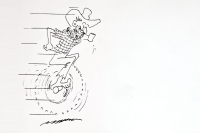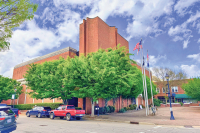What’s in a name? Town pride muddies selection of new Haywood tourism logo
 In a never-ending quest to lure tourists to Haywood County, the county tourism agency has once again changed the logo and slogan that will appear in its marketing and advertising materials.
In a never-ending quest to lure tourists to Haywood County, the county tourism agency has once again changed the logo and slogan that will appear in its marketing and advertising materials.
The new logo and slogan is meant to convey the Appalachian culture and heritage that sets Haywood County apart as a tourist destination.
“It is important for Haywood County to have a brand identity that captures the essence of this entire area,” said Ken Howle, a tourism board member and director of advancement with Lake Junaluska Conference and Retreat Center.
The new logo sports a country road rambling past a barn and farm fields and then disappearing into mountain peaks, with the silhouette of stately elk in the foreground and a meandering river in the background. Accompanied by the tagline “Authentic Appalachian, Pure and Simple,” it caters to a growing desire among today’s tourist to escape into an idyllic landscape and explore the vestiges of an authentic culture.
“‘Pure and simple,’ I like the connotation,” said Mike Graham, a tourism board member and owner of Jukebox Junction restaurant in Bethel. “No hustle-bustle, laid-back, friendly and easy going — that is basically what we sell here in Haywood County.”
Related Items
But settling on a new logo wasn’t without debate among members of the Haywood County Tourism Development Authority. Disagreement didn’t revolve around the nuts-and-bolts of the logo or slogan itself, however.
Instead, the biggest sticking point was whether the names of each town in the county should be inscribed on the logo.
The initial mock-up boldly proclaimed “Haywood County” across the face of the logo, with no other place names mentioned.
But several board members — the majority in fact — wanted the names of Waynesville, Maggie Valley, Lake Junaluska, Canton and Clyde all included as well. A vigorous discussion broke out during a meeting of the tourism board last week on whether the town names should be part of the logo.
“This is a huge, huge, huge decision for us. This may not be the time for us to make the motion saying ‘This is it.’ This is a work in progress,” cautioned Beth Brown, a tourism board member and owner of a photography business in Maggie Valley.
But Ken Stahl, chair of the tourism board and a retired major hotelier in the county, was determined to arrive at a logo by the end of the meeting.
“We need to do the best job we can today selecting a logo. It may take several votes to get there,” Stahl said.
Stahl then began calling for a series of piecemeal votes on what wording should be in the logo.
“Can we take a vote over whether you want the ‘North Carolina Smokies’ to be in the logo? Please raise your hand,” Stahl said.
A majority of hands went up.
“All those in favor of ‘Haywood County’ being in the logo please raise your hand,” Stahl said.
A majority of hands went up again.
“All those who are in favor of having ‘Authentic Appalachian, Pure and Simple’ in our logo please raise your hand,” Stahl said.
Hands went up.
When Stahl got to the final kicker — who wants the names of all the towns in the logo? — a majority of hands once again went up.
Mock-ups of the logo sporting various combinations of wording were flashed on a screen as Stahl called for the votes on whether this or that phrase should make the final cut.
At the end, Stahl turned to Tourism Director Lynn Collins, who was tracking the votes, and asked for the verdict.
“Everybody wants everything,” Collins said.
But everything, of course, wouldn’t fit in the logo, at least not legibly — and not given the already busy image of mountains, trees, a river, an elk, a barn, a silo and a winding country road.
The discussion then became mildly heated as board members debated which phrases to jettison from the crowded field.
Brown questioned the process, saying it was impossible to parse out the individual parts of the logo from the whole, and then mash them back up again. But Stahl said it was the only way to settle it.
“We have to somehow come up with a logo, and this is the best way,” Stahl said.
The debate over whether to stick town names in the logo harkened back to an age-old turf battle that pitted neighboring towns against each other for their fair share of tourism dollars. Towns would feel slighted if they didn’t get their just due by a mention in the logo, some board members said.
The towns also have better name recognition than Haywood County, said James Carver, owner of the Maggie Valley Restaurant. No one knows what county Myrtle Beach is in, Carver argued.
But Brown said the larger goal is to move past the old identity wars and approach tourism marketing collectively.
“Haywood County is about marketing to the whole, not just to the individual communities,” Brown said.
But the bigger problem was a logistical one. It was a challenge to fit all five town names in the logo. The leading version listed them in a oval ring, rimming the outer edge of the logo.
Howle kept reminding the board that the logo would often run small, just a few inches at best in most ads, and the ring of town names would simply be too tiny to read.
“You just muddy the whole thing down,” Howle said.
He suggested highlighting the names of towns elsewhere in the ad.
“We can use the town names in a way other than embedded in the logo in small print,” Howle said.
The board then called on Jeff Goss, president of the advertising agency contracted to do Haywood’s tourism marketing, to step up to the podium. Goss, somewhat reluctantly, shared his opinion — namely that the tourism draw of Haywood County didn’t lay with the towns.
“The individual towns aren’t the drivers, it is the collection of all of it together,” said Goss.
Stahl then called for another vote on whether town names should appear in the logo, and only two members — Howle and Brown — voted against the ring of town names around the edge. But Howle made one last case, again suggesting the names of the towns could appear somewhere else in the ad other than the logo itself.
Mike Sorrells, a Haywood County commissioner who sits on the tourism board, suggested a compromise.
“I am just trying to get everybody on board here. What about putting the towns underneath?” Sorrells asked.
It worked. The board switched gears and agreed that the town names could be listed below the logo, rather than crammed around the edge of the image.
With a final decision in hand, Goss said he would work on colorizing the black-and-white mock-up.
“Then we can argue about the color,” Stahl said in jest.
Back to the drawing board: ‘Homegrown in Haywood’ out; ‘Authentic Appalachian, Pure and Simple’ in
The search for a new logo by the Haywood County Tourism Development Authority had a twinge of déjà vu to it.
That’s because the old logo being scrapped isn’t all that old. It came out just two years ago alongside a new marketing campaign aimed at branding Haywood County as an authentic Appalachian destination.
It sported intertwining icons of Appalachian culture paired with the tagline “Homegrown in Haywood.” An apple, dulcimer, bottle, fish, painter’s pallet and quilting needle represented agriculture, music, craft food and beverages, outdoors, arts and crafts.
The Homegrown in Haywood campaign marked a major branding shift. The tourism pitch during the previous two decades used the mountains as its crutch: come to Haywood County because it’s in the Smokies.
The slogans “Gateway to the Smokies” and later “Where the Sun Rises on the Smokies” reigned during the 1990s and 2000s. But those slogans did little to set Haywood apart from any other mountain community.
“The Smokies is very generic. It is all over the place. It is going to be hard to own the Smokies,” said Jeff Goss, the owner of the Goss Agency, which has the marketing contract for the Haywood tourism authority.
The tourism authority undertook a major analysis to arrive at Haywood’s distinct drawing card.
“It is important in tourism marketing to have a unique proposition,” Howle said. “We are fortunate that Haywood County has some unique features that are uncommon elsewhere.”
Those unique features were a rich cultural landscape and authentic experience, wrapped up as “Homegrown in Haywood.”
Two years later, that’s being replaced with “Authentic Appalachian, Pure and Simple.” The slogan may be new, but the message is the same.
“It is just packaging it differently,” said Lynn Collins, executive director of the Haywood tourism authority.
Critics of the old “Homegrown in Haywood” slogan claimed it was too hard to decipher, and the meaning of the layered icons in the logo weren’t readily apparent.
“They felt like it was somewhat fragmented,” Collins said.
Half the members on the tourism board are new within the past two years, and so it’s not unexpected that the logo would be revisited.
“Whenever you have a change in a board there will be different ideas,” Collins said.
— By Becky Johnson









